MITSUBISHI SHOGUN 2017 Owner's Manual (in English)
Manufacturer: MITSUBISHI, Model Year: 2017, Model line: SHOGUN, Model: MITSUBISHI SHOGUN 2017Pages: 394, PDF Size: 19 MB
Page 181 of 394
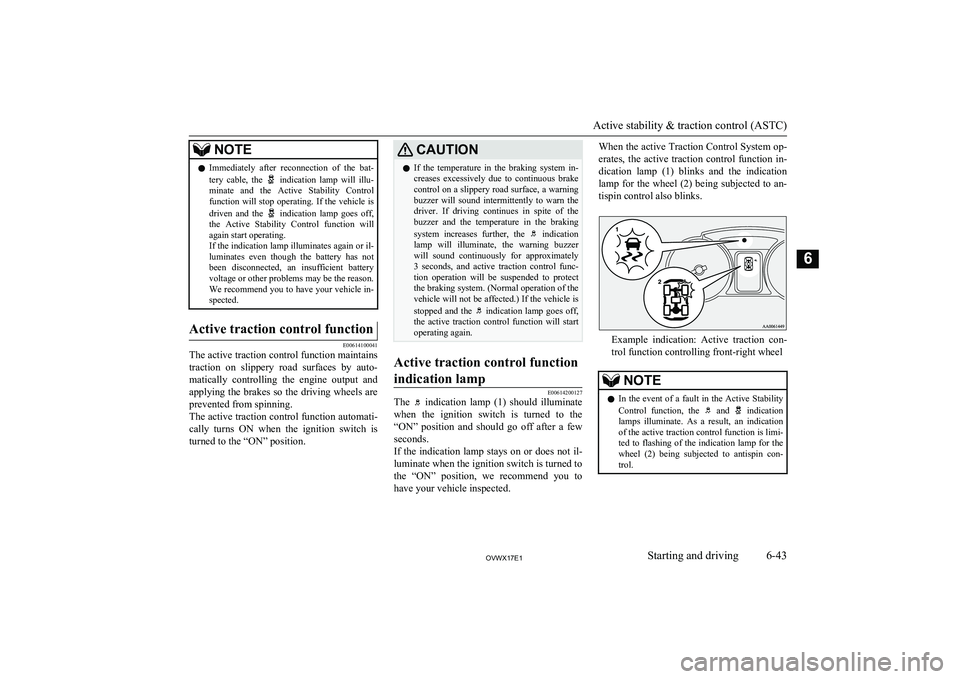
NOTElImmediately after reconnection of the bat-
tery cable, the indication lamp will illu-
minate and the Active Stability Control
function will stop operating. If the vehicle is
driven and the
indication lamp goes off,
the Active Stability Control function will
again start operating.
If the indication lamp illuminates again or il-
luminates even though the battery has not been disconnected, an insufficient battery
voltage or other problems may be the reason.
We recommend you to have your vehicle in- spected.
Active traction control function
E00614100041
The active traction control function maintains
traction on slippery road surfaces by auto-
matically controlling the engine output and applying the brakes so the driving wheels are prevented from spinning.
The active traction control function automati-
cally turns ON when the ignition switch is
turned to the “ON” position.
CAUTIONl If the temperature in the braking system in-
creases excessively due to continuous brake
control on a slippery road surface, a warning
buzzer will sound intermittently to warn the driver. If driving continues in spite of the
buzzer and the temperature in the braking
system increases further, the
indication
lamp will illuminate, the warning buzzer will sound continuously for approximately
3 seconds, and active traction control func- tion operation will be suspended to protectthe braking system. (Normal operation of thevehicle will not be affected.) If the vehicle is
stopped and the
indication lamp goes off,
the active traction control function will start
operating again.
Active traction control function
indication lamp
E00614200127
The indication lamp (1) should illuminate
when the ignition switch is turned to the
“ON” position and should go off after a few seconds.
If the indication lamp stays on or does not il-
luminate when the ignition switch is turned to
the “ON” position, we recommend you to
have your vehicle inspected.
When the active Traction Control System op-
erates, the active traction control function in-dication lamp (1) blinks and the indication
lamp for the wheel (2) being subjected to an- tispin control also blinks.
Example indication: Active traction con- trol function controlling front-right wheel
NOTEl In the event of a fault in the Active Stability
Control function, the and indication
lamps illuminate. As a result, an indication
of the active traction control function is limi- ted to flashing of the indication lamp for the
wheel (2) being subjected to antispin con- trol.
Active stability & traction control (ASTC)
6-43OVWX17E1Starting and driving6
Page 182 of 394
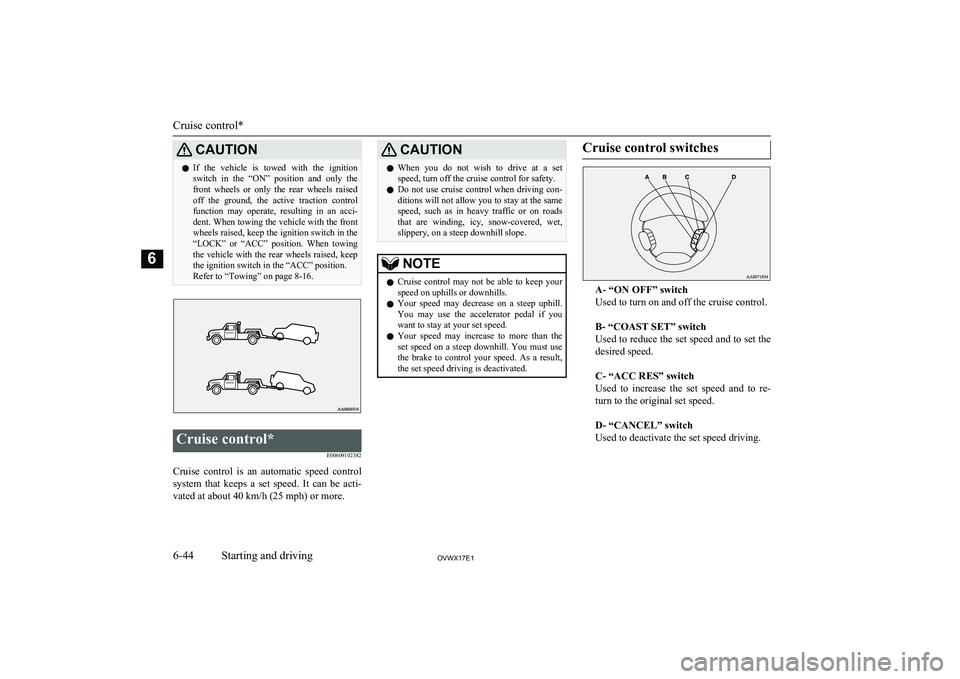
CAUTIONlIf the vehicle is towed with the ignition
switch in the “ON” position and only the
front wheels or only the rear wheels raised off the ground, the active traction control
function may operate, resulting in an acci-
dent. When towing the vehicle with the front wheels raised, keep the ignition switch in the
“LOCK” or “ACC” position. When towing the vehicle with the rear wheels raised, keep the ignition switch in the “ACC” position.
Refer to “Towing” on page 8-16.Cruise control*
E00609102382
Cruise control is an automatic speed controlsystem that keeps a set speed. It can be acti-vated at about 40 km/h (25 mph) or more.
CAUTIONl When you do not wish to drive at a set
speed, turn off the cruise control for safety.
l Do not use cruise control when driving con-
ditions will not allow you to stay at the same
speed, such as in heavy traffic or on roads that are winding, icy, snow-covered, wet,
slippery, on a steep downhill slope.NOTEl Cruise control may not be able to keep your
speed on uphills or downhills.
l Your speed may decrease on a steep uphill.
You may use the accelerator pedal if you
want to stay at your set speed.
l Your speed may increase to more than the
set speed on a steep downhill. You must use the brake to control your speed. As a result, the set speed driving is deactivated.Cruise control switches
A- “ON OFF” switch
Used to turn on and off the cruise control.
B- “COAST SET” switch
Used to reduce the set speed and to set the
desired speed.
C- “ACC RES” switch
Used to increase the set speed and to re- turn to the original set speed.
D- “CANCEL” switch
Used to deactivate the set speed driving.
Cruise control*
6-44OVWX17E1Starting and driving6
Page 183 of 394
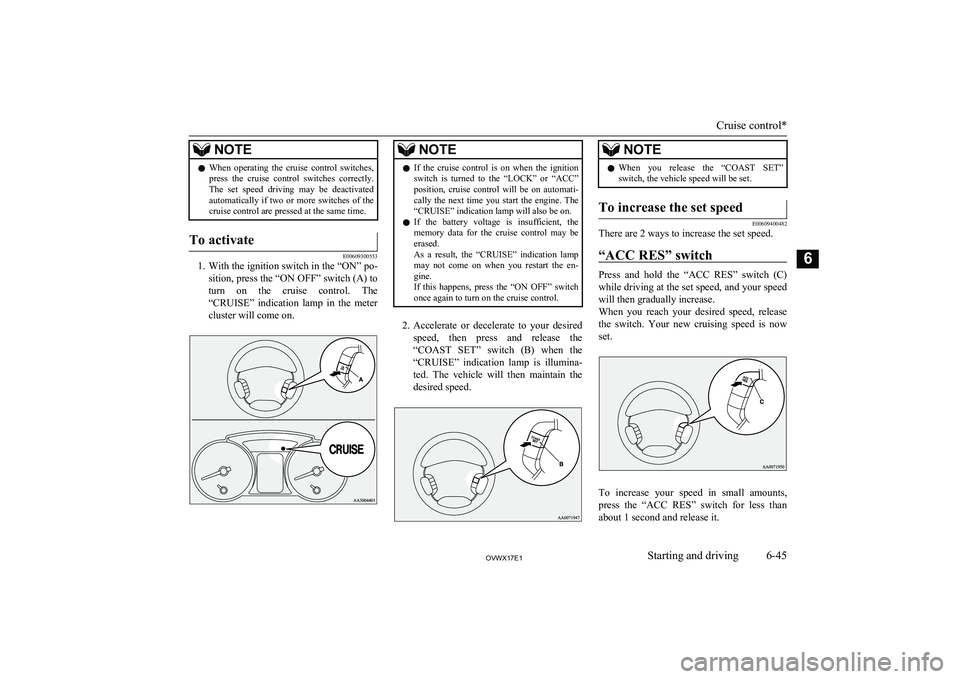
NOTElWhen operating the cruise control switches,
press the cruise control switches correctly.
The set speed driving may be deactivated automatically if two or more switches of the
cruise control are pressed at the same time.To activate
E00609300553
1. With the ignition switch in the “ON” po-
sition, press the “ON OFF” switch (A) to turn on the cruise control. The
“CRUISE” indication lamp in the meter cluster will come on.
NOTEl If the cruise control is on when the ignition
switch is turned to the “LOCK” or “ACC” position, cruise control will be on automati- cally the next time you start the engine. The
“CRUISE” indication lamp will also be on.
l If the battery voltage is insufficient, the
memory data for the cruise control may be erased.
As a result, the “CRUISE” indication lamp may not come on when you restart the en-
gine.
If this happens, press the “ON OFF” switch once again to turn on the cruise control.
2. Accelerate or decelerate to your desired
speed, then press and release the “COAST SET” switch (B) when the
“CRUISE” indication lamp is illumina- ted. The vehicle will then maintain the
desired speed.
NOTEl When you release the “COAST SET”
switch, the vehicle speed will be set.To increase the set speed
E00609400482
There are 2 ways to increase the set speed.
“ACC RES” switch
Press and hold the “ACC RES” switch (C)while driving at the set speed, and your speed
will then gradually increase.
When you reach your desired speed, release
the switch. Your new cruising speed is now set.
To increase your speed in small amounts,
press the “ACC RES” switch for less than about 1 second and release it.
Cruise control*
6-45OVWX17E1Starting and driving6
Page 184 of 394
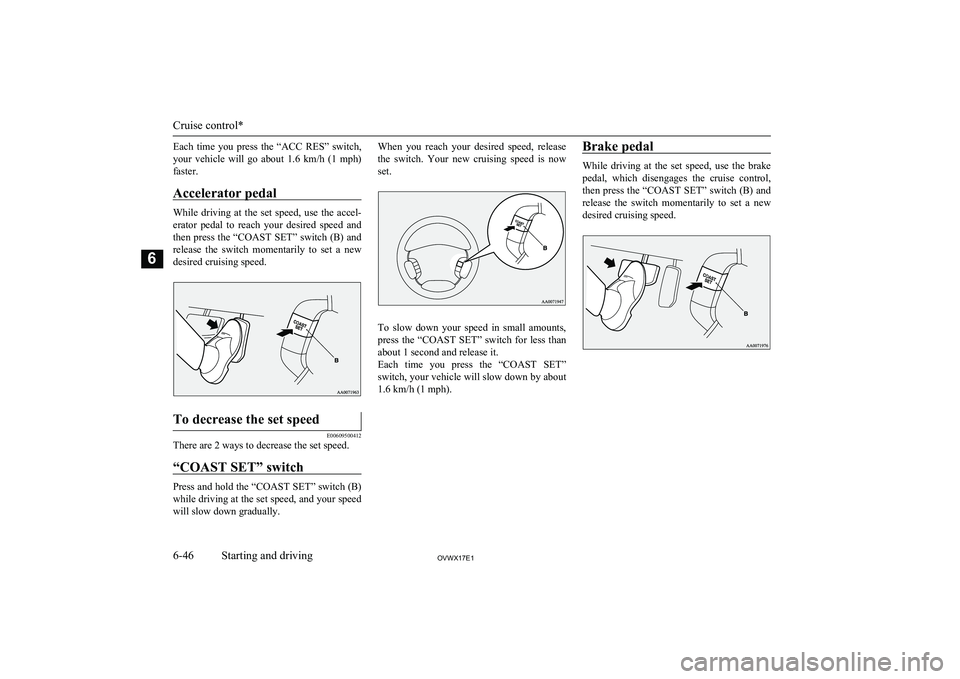
Each time you press the “ACC RES” switch,your vehicle will go about 1.6 km/h (1 mph)
faster.
Accelerator pedal
While driving at the set speed, use the accel-
erator pedal to reach your desired speed and
then press the “COAST SET” switch (B) and release the switch momentarily to set a new
desired cruising speed.
To decrease the set speed
E00609500412
There are 2 ways to decrease the set speed.
“COAST SET” switch
Press and hold the “COAST SET” switch (B)
while driving at the set speed, and your speed will slow down gradually.
When you reach your desired speed, release
the switch. Your new cruising speed is now set.
To slow down your speed in small amounts,
press the “COAST SET” switch for less than about 1 second and release it.
Each time you press the “COAST SET” switch, your vehicle will slow down by about
1.6 km/h (1 mph).
Brake pedal
While driving at the set speed, use the brake
pedal, which disengages the cruise control,
then press the “COAST SET” switch (B) and
release the switch momentarily to set a new desired cruising speed.Cruise control*
6-46OVWX17E1Starting and driving6
Page 185 of 394
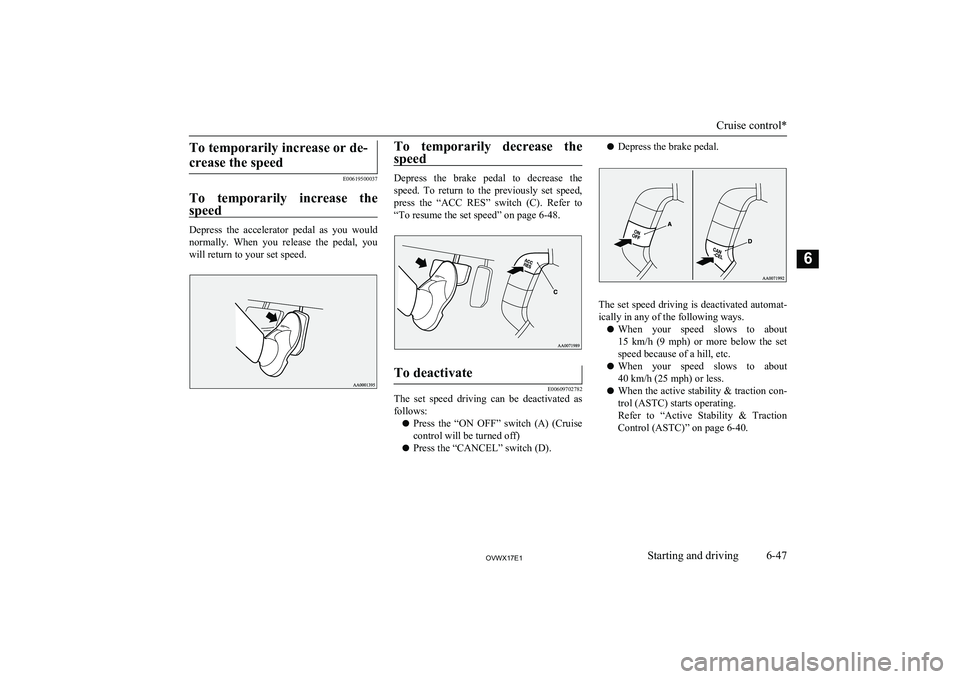
To temporarily increase or de-crease the speed
E00619500037
To temporarily increase the speed
Depress the accelerator pedal as you would
normally. When you release the pedal, you will return to your set speed.
To temporarily decrease the
speed
Depress the brake pedal to decrease the speed. To return to the previously set speed,
press the “ACC RES” switch (C). Refer to
“To resume the set speed” on page 6-48.
To deactivate
E00609702782
The set speed driving can be deactivated as follows:
l Press the “ON OFF” switch (A) (Cruise
control will be turned off)
l Press the “CANCEL” switch (D).
lDepress the brake pedal.
The set speed driving is deactivated automat-
ically in any of the following ways.
l When your speed slows to about
15 km/h (9 mph) or more below the set speed because of a hill, etc.
l When your speed slows to about
40 km/h (25 mph) or less.
l When the active stability & traction con-
trol (ASTC) starts operating.
Refer to “Active Stability & Traction
Control (ASTC)” on page 6-40.
Cruise control*
6-47OVWX17E1Starting and driving6
Page 186 of 394
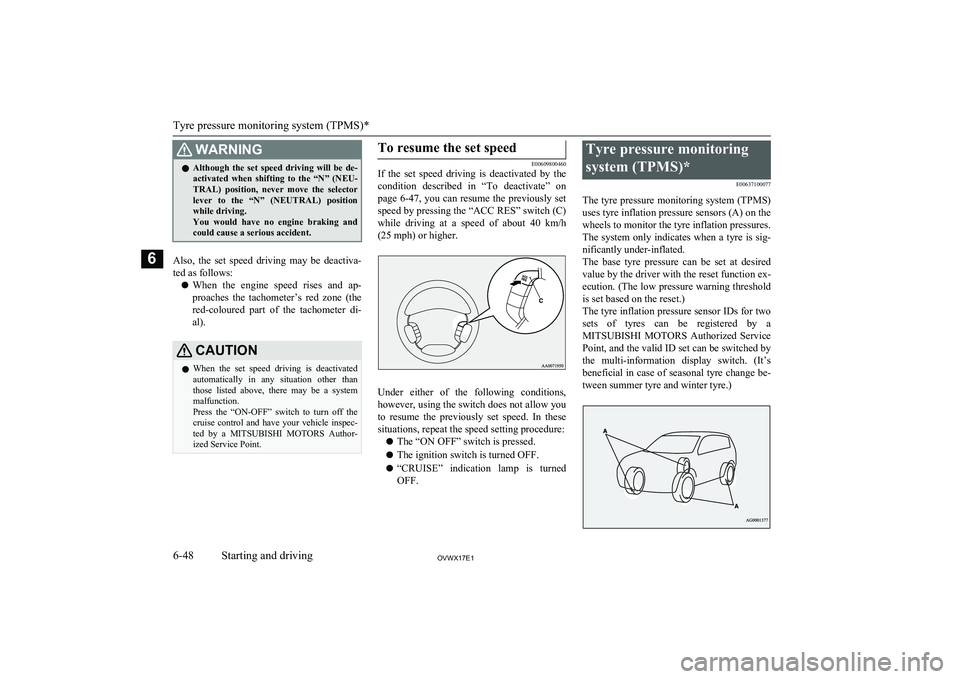
WARNINGlAlthough the set speed driving will be de-
activated when shifting to the “N” (NEU-
TRAL) position, never move the selector lever to the “N” (NEUTRAL) position
while driving.
You would have no engine braking and
could cause a serious accident.
Also, the set speed driving may be deactiva-
ted as follows:
l When the engine speed rises and ap-
proaches the tachometer’s red zone (the red-coloured part of the tachometer di-
al).
CAUTIONl When the set speed driving is deactivated
automatically in any situation other thanthose listed above, there may be a system
malfunction.
Press the “ON-OFF” switch to turn off the cruise control and have your vehicle inspec- ted by a MITSUBISHI MOTORS Author-
ized Service Point.To resume the set speed
E00609800460
If the set speed driving is deactivated by the
condition described in “To deactivate” on
page 6-47, you can resume the previously set
speed by pressing the “ACC RES” switch (C)
while driving at a speed of about 40 km/h (25 mph) or higher.
Under either of the following conditions,however, using the switch does not allow you
to resume the previously set speed. In these
situations, repeat the speed setting procedure:
l The “ON OFF” switch is pressed.
l The ignition switch is turned OFF.
l “CRUISE” indication lamp is turned
OFF.
Tyre pressure monitoring
system (TPMS)* E00637100077
The tyre pressure monitoring system (TPMS)
uses tyre inflation pressure sensors (A) on the wheels to monitor the tyre inflation pressures.
The system only indicates when a tyre is sig-
nificantly under-inflated.
The base tyre pressure can be set at desired value by the driver with the reset function ex-
ecution. (The low pressure warning threshold is set based on the reset.)
The tyre inflation pressure sensor IDs for two sets of tyres can be registered by aMITSUBISHI MOTORS Authorized Service
Point, and the valid ID set can be switched by the multi-information display switch. (It’s
beneficial in case of seasonal tyre change be-
tween summer tyre and winter tyre.)
Tyre pressure monitoring system (TPMS)*
6-48OVWX17E1Starting and driving6
Page 187 of 394
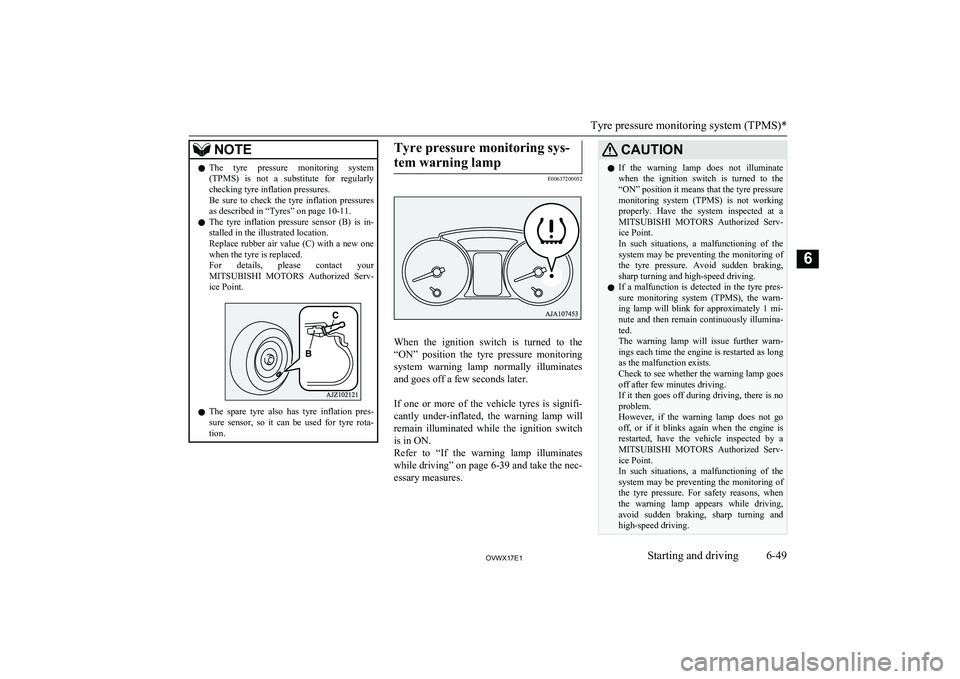
NOTElThe tyre pressure monitoring system
(TPMS) is not a substitute for regularlychecking tyre inflation pressures.
Be sure to check the tyre inflation pressures as described in “Tyres” on page 10-11.
l The tyre inflation pressure sensor (B) is in-
stalled in the illustrated location.
Replace rubber air value (C) with a new one when the tyre is replaced.
For details, please contact your
MITSUBISHI MOTORS Authorized Serv-
ice Point.
l The spare tyre also has tyre inflation pres-
sure sensor, so it can be used for tyre rota- tion.
Tyre pressure monitoring sys-
tem warning lamp
E00637200052
When the ignition switch is turned to the
“ON” position the tyre pressure monitoring system warning lamp normally illuminates
and goes off a few seconds later.
If one or more of the vehicle tyres is signifi- cantly under-inflated, the warning lamp will
remain illuminated while the ignition switch is in ON.
Refer to “If the warning lamp illuminates while driving” on page 6-39 and take the nec-essary measures.
CAUTIONl If the warning lamp does not illuminate
when the ignition switch is turned to the
“ON” position it means that the tyre pressure monitoring system (TPMS) is not working
properly. Have the system inspected at a MITSUBISHI MOTORS Authorized Serv-
ice Point.
In such situations, a malfunctioning of the system may be preventing the monitoring of the tyre pressure. Avoid sudden braking,
sharp turning and high-speed driving.
l If a malfunction is detected in the tyre pres-
sure monitoring system (TPMS), the warn-
ing lamp will blink for approximately 1 mi-
nute and then remain continuously illumina- ted.
The warning lamp will issue further warn-
ings each time the engine is restarted as long
as the malfunction exists.
Check to see whether the warning lamp goes
off after few minutes driving.
If it then goes off during driving, there is no problem.
However, if the warning lamp does not go off, or if it blinks again when the engine is
restarted, have the vehicle inspected by a
MITSUBISHI MOTORS Authorized Serv-
ice Point.
In such situations, a malfunctioning of the system may be preventing the monitoring of
the tyre pressure. For safety reasons, when the warning lamp appears while driving,
avoid sudden braking, sharp turning and high-speed driving.
Tyre pressure monitoring system (TPMS)*
6-49OVWX17E1Starting and driving6
Page 188 of 394
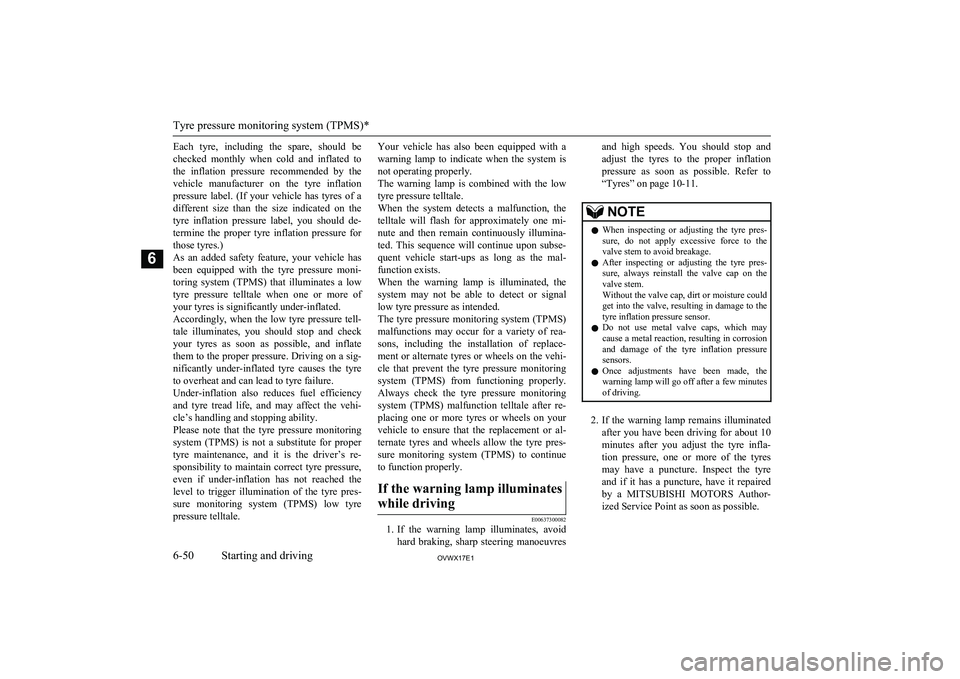
Each tyre, including the spare, should be
checked monthly when cold and inflated to the inflation pressure recommended by thevehicle manufacturer on the tyre inflation
pressure label. (If your vehicle has tyres of a different size than the size indicated on the
tyre inflation pressure label, you should de-
termine the proper tyre inflation pressure for those tyres.)
As an added safety feature, your vehicle has been equipped with the tyre pressure moni-
toring system (TPMS) that illuminates a low
tyre pressure telltale when one or more of
your tyres is significantly under-inflated.
Accordingly, when the low tyre pressure tell-
tale illuminates, you should stop and check your tyres as soon as possible, and inflate
them to the proper pressure. Driving on a sig- nificantly under-inflated tyre causes the tyre to overheat and can lead to tyre failure.
Under-inflation also reduces fuel efficiency
and tyre tread life, and may affect the vehi- cle’s handling and stopping ability.
Please note that the tyre pressure monitoring
system (TPMS) is not a substitute for proper tyre maintenance, and it is the driver’s re-sponsibility to maintain correct tyre pressure,
even if under-inflation has not reached the level to trigger illumination of the tyre pres-
sure monitoring system (TPMS) low tyre pressure telltale.Your vehicle has also been equipped with a
warning lamp to indicate when the system is
not operating properly.
The warning lamp is combined with the low
tyre pressure telltale.
When the system detects a malfunction, the telltale will flash for approximately one mi-nute and then remain continuously illumina-
ted. This sequence will continue upon subse- quent vehicle start-ups as long as the mal-
function exists.
When the warning lamp is illuminated, the
system may not be able to detect or signal low tyre pressure as intended.
The tyre pressure monitoring system (TPMS)
malfunctions may occur for a variety of rea- sons, including the installation of replace- ment or alternate tyres or wheels on the vehi-
cle that prevent the tyre pressure monitoring system (TPMS) from functioning properly.
Always check the tyre pressure monitoring system (TPMS) malfunction telltale after re- placing one or more tyres or wheels on yourvehicle to ensure that the replacement or al-
ternate tyres and wheels allow the tyre pres- sure monitoring system (TPMS) to continueto function properly.If the warning lamp illuminates
while driving
E00637300082
1. If the warning lamp illuminates, avoid
hard braking, sharp steering manoeuvres
and high speeds. You should stop and
adjust the tyres to the proper inflationpressure as soon as possible. Refer to
“Tyres” on page 10-11.NOTEl When inspecting or adjusting the tyre pres-
sure, do not apply excessive force to the valve stem to avoid breakage.
l After inspecting or adjusting the tyre pres-
sure, always reinstall the valve cap on the valve stem.
Without the valve cap, dirt or moisture could
get into the valve, resulting in damage to the tyre inflation pressure sensor.
l Do not use metal valve caps, which may
cause a metal reaction, resulting in corrosion
and damage of the tyre inflation pressure sensors.
l Once adjustments have been made, the
warning lamp will go off after a few minutes of driving.
2. If the warning lamp remains illuminated
after you have been driving for about 10
minutes after you adjust the tyre infla- tion pressure, one or more of the tyresmay have a puncture. Inspect the tyreand if it has a puncture, have it repaired
by a MITSUBISHI MOTORS Author-
ized Service Point as soon as possible.
Tyre pressure monitoring system (TPMS)*
6-50OVWX17E1Starting and driving6
Page 189 of 394
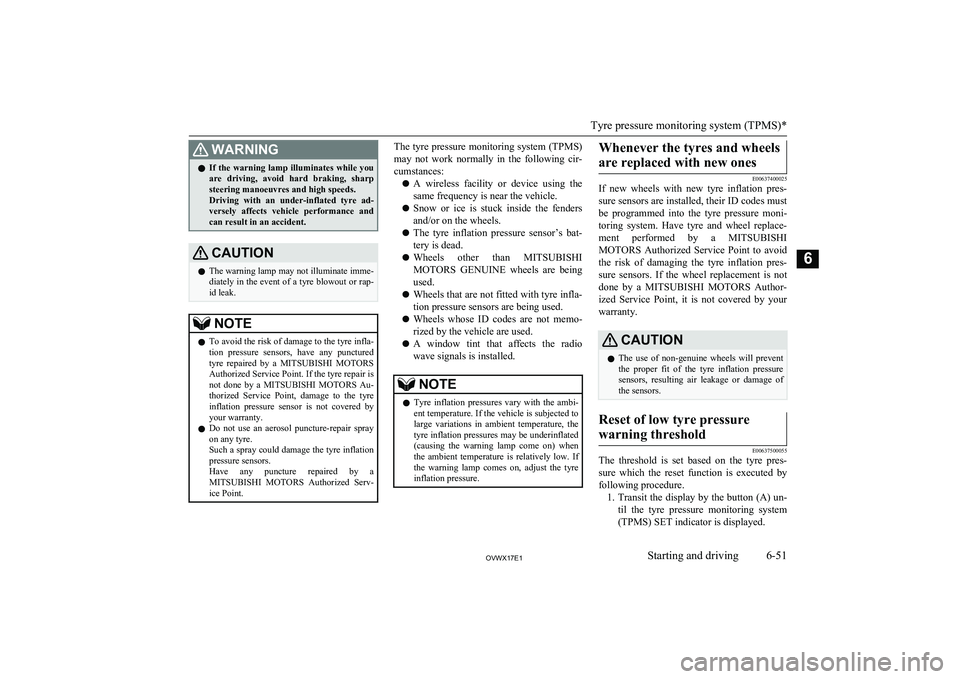
WARNINGlIf the warning lamp illuminates while you
are driving, avoid hard braking, sharp steering manoeuvres and high speeds.
Driving with an under-inflated tyre ad-
versely affects vehicle performance and
can result in an accident.CAUTIONl The warning lamp may not illuminate imme-
diately in the event of a tyre blowout or rap-
id leak.NOTEl To avoid the risk of damage to the tyre infla-
tion pressure sensors, have any punctured
tyre repaired by a MITSUBISHI MOTORS
Authorized Service Point. If the tyre repair is
not done by a MITSUBISHI MOTORS Au-
thorized Service Point, damage to the tyre
inflation pressure sensor is not covered by your warranty.
l Do not use an aerosol puncture-repair spray
on any tyre.
Such a spray could damage the tyre inflation
pressure sensors.
Have any puncture repaired by a MITSUBISHI MOTORS Authorized Serv-
ice Point.The tyre pressure monitoring system (TPMS)
may not work normally in the following cir-
cumstances:
l A wireless facility or device using the
same frequency is near the vehicle.
l Snow or ice is stuck inside the fenders
and/or on the wheels.
l The tyre inflation pressure sensor’s bat-
tery is dead.
l Wheels other than
MITSUBISHI
MOTORS GENUINE wheels are being
used.
l Wheels that are not fitted with tyre infla-
tion pressure sensors are being used.
l Wheels whose ID codes are not memo-
rized by the vehicle are used.
l A window tint that affects the radio
wave signals is installed.NOTEl Tyre inflation pressures vary with the ambi-
ent temperature. If the vehicle is subjected to large variations in ambient temperature, the tyre inflation pressures may be underinflated
(causing the warning lamp come on) when the ambient temperature is relatively low. If
the warning lamp comes on, adjust the tyre inflation pressure.Whenever the tyres and wheels
are replaced with new ones
E00637400025
If new wheels with new tyre inflation pres-
sure sensors are installed, their ID codes must be programmed into the tyre pressure moni- toring system. Have tyre and wheel replace-
ment performed by a MITSUBISHI
MOTORS Authorized Service Point to avoid
the risk of damaging the tyre inflation pres- sure sensors. If the wheel replacement is not
done by a MITSUBISHI MOTORS Author-
ized Service Point, it is not covered by your warranty.
CAUTIONl The use of non-genuine wheels will prevent
the proper fit of the tyre inflation pressure sensors, resulting air leakage or damage of
the sensors.Reset of low tyre pressure
warning threshold
E00637500055
The threshold is set based on the tyre pres- sure which the reset function is executed by
following procedure. 1. Transit the display by the button (A) un-
til the tyre pressure monitoring system
(TPMS) SET indicator is displayed.
Tyre pressure monitoring system (TPMS)*
6-51OVWX17E1Starting and driving6
Page 190 of 394
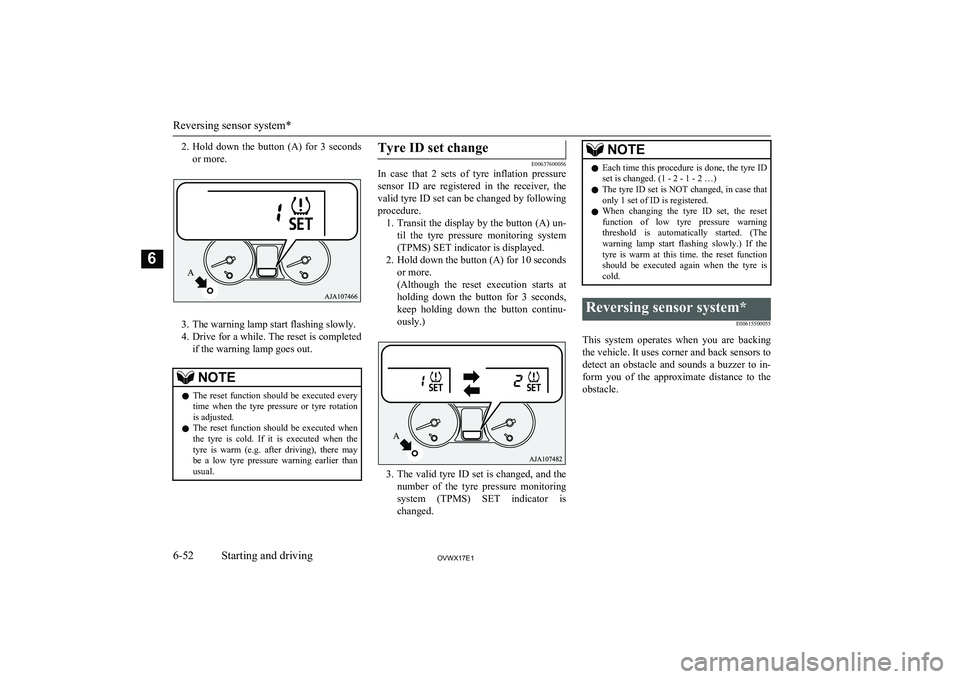
2.Hold down the button (A) for 3 seconds
or more.
3. The warning lamp start flashing slowly.
4. Drive for a while. The reset is completed
if the warning lamp goes out.
NOTEl The reset function should be executed every
time when the tyre pressure or tyre rotationis adjusted.
l The reset function should be executed when
the tyre is cold. If it is executed when the
tyre is warm (e.g. after driving), there may be a low tyre pressure warning earlier than
usual.Tyre ID set change
E00637600056
In case that 2 sets of tyre inflation pressure
sensor ID are registered in the receiver, the
valid tyre ID set can be changed by following
procedure. 1. Transit the display by the button (A) un-
til the tyre pressure monitoring system
(TPMS) SET indicator is displayed.
2. Hold down the button (A) for 10 seconds or more.
(Although the reset execution starts at
holding down the button for 3 seconds, keep holding down the button continu-
ously.)
3. The valid tyre ID set is changed, and the
number of the tyre pressure monitoring
system (TPMS) SET indicator is changed.
NOTEl Each time this procedure is done, the tyre ID
set is changed. (1 - 2 - 1 - 2 …)
l The tyre ID set is NOT changed, in case that
only 1 set of ID is registered.
l When changing the tyre ID set, the reset
function of low tyre pressure warning
threshold is automatically started. (The warning lamp start flashing slowly.) If the
tyre is warm at this time. the reset function
should be executed again when the tyre is cold.Reversing sensor system*
E00615500055
This system operates when you are backingthe vehicle. It uses corner and back sensors to detect an obstacle and sounds a buzzer to in-form you of the approximate distance to the
obstacle.
Reversing sensor system*
6-52OVWX17E1Starting and driving6